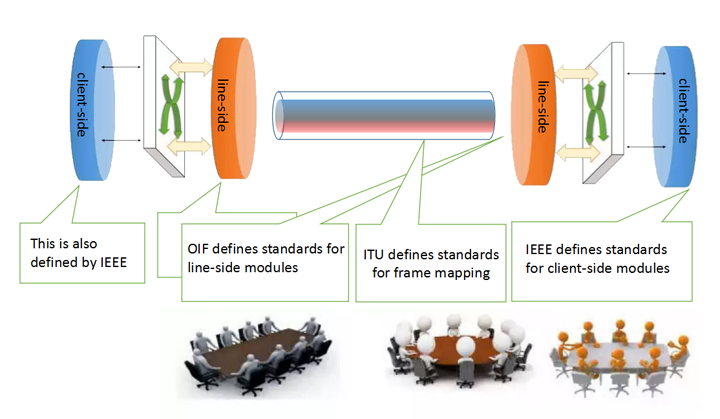The Role of IEEE/ITU/OIF in Defining 100G Ethernet Standards
100G transceivers play a crucial role in 100 Gigabit Ethernet and high-capacity optical transmission networks. As a key component, 100G transceivers are standardized to meet the data rate of 100Gpbs and ensure quality and reliability. IEEE, ITU, and OIF are standard organizations dedicated to formulating 100G Ethernet standards. This article delves into the pivotal roles of IEEE/ITU/OIF in standardizing 100G transceivers and defining 100G Ethernet standards.
What is IEEE/ITU/OIF?
Before delving into their roles in standardization, let's briefly introduce IEEE, ITU, and OIF individually.
IEEE Standard
Institute of Electrical and Electronics Engineers (IEEE) was formed by American Institute of Electrical Engineers (AIEE) and American Institute of Radio Engineer (IRE) in 1963. It has about 430,000 members in about 160 countries to advance technological innovation and excellence. In addition, IEEE performs its standards-making and maintaining functions through the IEEE Standards Association (IEEE-SA).
ITU Standard
ITU, originally the International Telegraph Union, is responsible for issues that concern information and communication technologies. As shown in the following figure, the ITU comprises three sectors (ITU-R, ITU-T, and ITU-D). Each sector manages a different aspect of the matters handled by the Union. ITU was formed in 1865 and was one of the 15 specialized agencies of the United Nations. Its membership includes 193 member states and around 700 public and private sectors.
OIF Standard
As a non-profit organization founded in 1998, Optical Internetworking Forum (OIF) is responsible for promoting the development and deployment of interoperable computer networking products and services through implementation agreements for optical networking products, network processing elements, and component technologies. OIF established the 100G Working Group in 2004 and the 400G Working Group in 2014.
How Does IEEE/ITU/OIF Help Define 100G Ethernet Standard?
The following picture shows the most popular solution of the 100G transceiver network, which is mainly divided into 100G client-side, 100G frame mapping, and 100G line-side. This is the basis of what roles IEEE, ITU, and OIF play in standardizing 100G transceivers and defining 100G Ethernet standards.
As mentioned above, IEEE, ITU, and OIF are responsible for 100G client-side, 100G frame mapping, and 100G line-side respectively. To be specific, IEEE defines IEEE standards for client-side transceivers, ITU defines ITU standards for frame mapping, and OIF defines OIF standards for line-side transceivers.
IEEE vs. ITU vs. OIF: Standards on 100G Transceivers
We've learned that IEEE standards are applied to the client side, ITU standards govern frame mapping, and OIF standards pertain to the line side. Now, let's delve deeper into how IEEE, ITU, and OIF play distinct roles in defining 100G Ethernet standards.
IEEE standards are applied on client-side 100G transceivers that are usually hot-swappable and are used for the external ports of optical transport networks (OTN). Generally, the client side covers short distances, ranging from 50m up to 10km and with only one transceiver connected to a fiber so that no DWDM is needed. Although the transmission distance is relatively short, IEEE standards allow 100G transceivers to be used with G652 fiber optic cable or multimode fiber optic cable.
OIF standards are applied on line-side 100G transceivers. WDM, polarization multiplexing, coherent modulation, and other technologies are widely used. The line side refers to much longer transmission distances of 80km and uses DWDM so that each transceiver can use only one wavelength channel. Although OIF standards allow line-side 100G transceivers a large capacity and long transmission distance, those transceivers are relatively more expensive than client-side 100G transceivers.
ITU standards work on 100G frame mapping. It is actually the mapping of OTUC (Fully standardized Optical Transport Unit) into FlexO (Flexible OTN) frame. OTUCn based on ITU-T G. 709 and supplementary documents allow the transport of services beyond 100G, and enables line side transport structures beyond 1Tbps.

Summary
100G transceivers provide an ideal way to realize greater bandwidth at a lower cost per bit. IEEE, ITU, and OIF are all striving to formulate 100G Ethernet standards. Though they define standards concerning different aspects, each of them plays an indispensable role in the fast and steady development of modern optical networks, especially optical transceivers.
Note:
ITU-R: ITU Telecommunication Radiocommunication Sector
ITU-T: ITU Telecommunication Standardization Sector
ITU-D: ITU Telecommunication Development Sector
WTSA: World Telecommunication Standardization Assembly
WCIT: World Conference on International Telecommunications
You might be interested in
Email Address

-
PoE vs PoE+ vs PoE++ Switch: How to Choose?
May 30, 2024




















